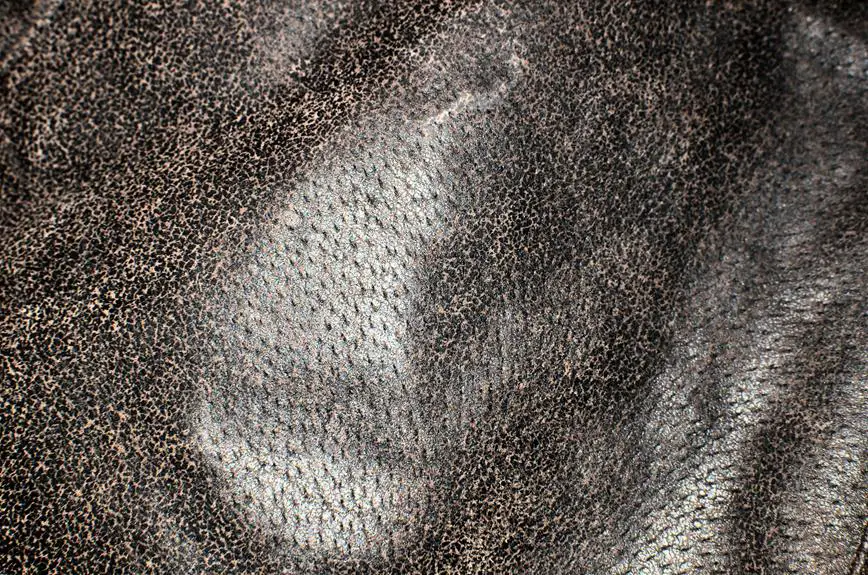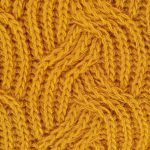When considering whether chenille is suitable for your sensitive skin, you might find its soft, plush texture appealing. It's known for being hypoallergenic, which can decrease the risk of irritation. However, the raised fibers might also trap dust and allergens, posing a potential concern. Plus, depending on the fabric blend, you could encounter moisture retention that might be uncomfortable. So, how do you navigate these pros and cons to find the right chenille for your needs? Understanding the intricacies of this fabric might just change your perspective on comfort and durability.
Table of Contents
Understanding Chenille Fabric
Chenille fabric, known for its soft texture and plush feel, is created by weaving lengths of yarn to form a unique, velvety surface that many people find appealing.
This fabric originates from the French word for 'caterpillar,' reflecting its soft and fuzzy appearance. You'll notice that chenille often comes in vibrant colors, which enhance its visual allure, making it a popular choice for home décor and clothing.
When you touch chenille, its luxurious softness immediately stands out. This texture results from the chenille yarn, which features a central core wrapped with shorter fibers, producing a lush finish. You might find chenille in a variety of products, from cozy blankets to stylish upholstery.
Additionally, its versatility allows it to integrate seamlessly into many design styles, whether contemporary or traditional.
When considering your next purchase, think about the appealing aesthetic and comfortable touch that chenille provides. It's essential to note, though, that not all chenille fabrics are created equal. The quality can vary, so it's worth taking the time to choose a high-quality piece that's both beautiful and durable for your needs.
Properties of Chenille
Many appreciate chenille for its unique combination of softness, durability, and warmth, making it ideal for various applications in clothing and home décor. This fabric features a velvety texture created by its looped yarns, which enhances its cozy feel. When you touch chenille, you'll immediately notice its plush quality, providing an indulgent experience that many cherish.
Chenille's durability comes from its construction. The fibers, often made from cotton, polyester, or a blend, are tightly woven, which helps prevent fraying and wear over time. This makes chenille a long-lasting choice for throws, blankets, and cushions.
Additionally, chenille is relatively lightweight, allowing it to retain warmth without being overly heavy or cumbersome. This balance of warmth and breathability makes it comfortable across varying temperatures.
Unlike some other fabrics, chenille holds color well, maintaining its vibrant hues even after multiple washes. These properties combine to make chenille an appealing option for anyone seeking fabric that merges comfort with resilience. Whether you're considering clothing or decorative items, you'll find that chenille offers a delightful blend of characteristics that enhance any collection.
Benefits for Sensitive Skin
If you have sensitive skin, you'll appreciate the soft texture of chenille, which feels gentle against your skin.
Its hypoallergenic properties also mean it's less likely to cause irritation, making it a great choice for those prone to allergies.
Let's explore how these benefits can enhance your comfort and well-being.
Soft Texture Advantage
For those with sensitive skin, the soft texture of chenille offers a comforting embrace that minimizes irritation and enhances overall comfort. Unlike harsher fabrics, chenille's plush fibers gently caress your skin, providing a soothing experience. You'll quickly notice how it avoids the scratchiness that can aggravate sensitive areas, allowing you to enjoy cozy blankets or soft clothing without fear of discomfort.
Imagine wrapping yourself in chenille and feeling the soft fibers against your skin. Here's a quick visualization of its advantages:
| Feature | Chenille | Rough Fabrics |
|---|---|---|
| Texture | Soft and velvety | Coarse and scratchy |
| Skin Reaction | Minimal irritation | Often causes redness |
| Comfort Level | High | Low to moderate |
| Ideal for | Sensitive skin | General use |
Choosing chenille means embracing softness, which plays an essential role in minimizing discomfort. It's a practical option for your sensitive skin, turning every encounter into a gentle experience that you'll appreciate day after day.
Hypoallergenic Properties Explained
Chenille's hypoallergenic properties make it an ideal choice for those prone to skin sensitivities, as it resists common allergens like dust mites and mold. By using chenille fabrics, you can create a more comfortable environment in your living space, especially if you have allergies or sensitive skin. Unlike many other materials that can trap allergens, chenille's unique texture helps to minimize the accumulation of dust and other irritants.
When you choose chenille, you reduce the risk of skin irritations often triggered by harsher fabrics. Its soft, plush surface means you won't have to worry about rough textures exacerbating your sensitivities. Additionally, because chenille is frequently made from synthetic fibers, it's less likely to contain natural allergens like wool or exotic blends that might cause flare-ups.
Moreover, chenille is easy to care for, allowing you to maintain its cleanliness without much hassle. Regular washing can help eliminate any residual allergens, further protecting your sensitive skin. Opting for chenille can ultimately lead to a cozy atmosphere where skin irritations are minimized, allowing you to enjoy comfort without worry.
Potential Drawbacks of Chenille
While many people enjoy the softness of chenille, it can sometimes cause irritation for those with sensitive skin.
One potential drawback is its construction. Chenille is made with raised fibers, which might feel pleasant initially, but these fibers can trap dust and allergens. If you're prone to allergies, this could exacerbate your symptoms.
You should also consider the maintenance of chenille. It often requires special care, like gentle washing and air drying, to maintain its texture. If you neglect this, you might end up with a fabric that feels scratchy or uncomfortable against your skin, triggering irritation.
Another factor to think about is heat retention. Chenille is warm and cozy, but if you tend to overheat easily, wearing it might lead to sweating and discomfort. This can further irritate your sensitive skin.
Lastly, some chenille fabrics are blended with synthetic fibers, which mightn't breathe as well as natural fibers. This can lead to moisture build-up and create an environment for irritation or even breakouts. So, if you have sensitive skin, you might want to tread carefully when choosing chenille products.
Comparison With Other Fabrics
When comparing chenille to other fabrics, it's essential to consider how each material interacts with sensitive skin. Chenille is often softer and plusher than many alternatives, providing a cozy feel that many find soothing.
Unlike rougher options like burlap or some synthetic blends, chenille tends to avoid causing irritation, making it a more favorable choice for those with sensitivities.
However, if you're comparing chenille to cotton, you might find that 100% cotton can also be gentle on your skin. Cotton is breathable and hypoallergenic, which means it usually won't provoke allergies or irritation.
Meanwhile, materials like polyester or wool can be less forgiving; polyester might trap heat and moisture, leading to discomfort, and wool can be itchy for some.
Bamboo fabrics are another alternative that you might consider. Like chenille, bamboo textiles are soft and breathable, often making them a great option for those with sensitive skin.
While chenille excels in plushness, bamboo provides excellent moisture-wicking properties. In your search for comfort, assessing how each fabric feels against your skin is crucial to finding what works best for you.
Care Instructions for Chenille
Caring for chenille requires a few simple steps to keep it looking and feeling its best. Start by checking the care label, as different blends may have specific instructions. Generally, it's best to wash chenille in cold water on a gentle cycle to prevent damage. If you're hand washing, use lukewarm water and a mild detergent.
Avoid using bleach, as it can ruin the fabric's texture and color. After washing, lay the chenille flat to dry, instead of hanging, which can stretch the fibers. If you must tumble dry, use the lowest heat setting and remove it while slightly damp, so you can reshape it before it fully dries.
When it comes to storing chenille, keep it in a cool, dry place. Avoid overcrowding, as this can cause permanent creases. You can gently shake out any dust or lint. If your chenille needs ironing, use a low-heat setting and place a cloth between the iron and the fabric to protect it. Following these steps will help maintain your chenille's softness and appearance, ensuring it remains a cozy addition to your wardrobe or home decor.
Recommendations for Sensitive Skin
Understanding how to care for chenille also involves considering its suitability for sensitive skin, as certain materials can either irritate or comfort your skin. If you experience sensitivity, it's crucial to choose chenille products that prioritize your comfort.
- Opt for High-Quality Chenille: Look for chenille made from natural fibers like cotton or bamboo. These materials are generally gentler on the skin compared to synthetic alternatives.
- Check for Certifications: Ensure the chenille products come with certifications like OEKO-TEX Standard 100. This verifies that the fabric is free from harmful substances, reducing the risk of irritation.
- Wash Before Use: Always wash new chenille items before wearing or using them. This removes any residual chemicals or dyes that could cause sensitivity.
Frequently Asked Questions
Can Chenille Cause Allergic Reactions in Sensitive Individuals?
Yes, chenille can cause allergic reactions in sensitive individuals. Its fibers may irritate your skin or trigger allergies. If you've experienced reactions before, it's best to test a small area before using chenille extensively.
Is Organic Chenille Available for Those With Sensitive Skin?
Yes, you can find organic chenille options that cater to your needs. These fabrics are typically made from natural fibers, minimizing chemical exposure and making them a gentler choice for those with sensitivities.
How Does Chenille Feel Against the Skin Compared to Cotton?
When you compare chenille to cotton, you'll notice chenille feels softer and plusher. It provides a cozy texture that many find appealing, while cotton offers a more breathable, crisp sensation against your skin.
Are There Specific Brands Known for Sensitive Skin-Friendly Chenille?
When searching for brands that offer sensitive skin-friendly chenille, consider options like Barefoot Dreams, Pottery Barn, and Eileen Fisher. These brands often prioritize soft materials, minimizing irritation while delivering cozy and stylish choices for your needs.
Is Chenille Machine Washable for Easy Cleaning?
Absolutely, chenille's often machine washable, making cleaning a breeze. Just check the care label for specific instructions, and you'll find it's easy to maintain, helping you keep your space looking fresh without hassle.
- Decoding Fabric Labels: What “Angora Blend” Really Means - July 2, 2025
- Is Angora a Natural Fiber? The Complete Answer - July 2, 2025
- The Different Types of Angora Rabbits and Their Wool - July 2, 2025







